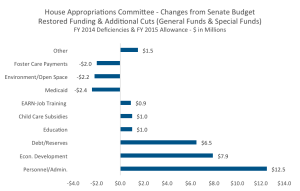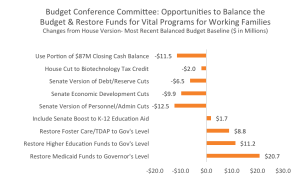Budget Negotiators Should Restore Funds for Vital Services and Programs for Working Families
As Maryland lawmakers start working out differences between the Senate and House budget plans, they should take advantage of numerous options to fully restore unwise and unnecessary cuts to needed programs and services for working families.
The House budget does restore funding to some programs cut in the Senate’s version, but some of its other provisions would hurt working families. The House budget restores $900,000 for the Employment Advancement Right Now (EARN) job training program; $1 million for child care subsidies; and $2 million for the Early College Innovation Fund, which provides seed funding to school systems to start early college access programs. At the same time, the House budget cuts $1.7 million in K-12 education aid added by the Senate.
Though the House cuts higher education slightly less than the Senate, it would still provide $11.2 million less to colleges and universities than Governor O’Malley’s plan. Reduced state support for higher education can lead to higher tuition for students and families.
The House budget also cuts state Medicaid funds by an additional $2.4 million, bringing them to $20.7 million. Since state Medicaid dollars are matched by federal funds, the total Medicaid reduction would be $41.4 million. Cuts to Medicaid providers can make it difficult for patients to get the care they need.
The House cut foster care funds by an additional $2 million, bringing the total cut to $5 million. It cut the same amount as the Senate, $3.8 million, from the Temporary Disability Assistance Program, which helps disabled, low-income adults while they are awaiting eligibility determination for federal disability support.
Source: House Appropriations Committee (click to enlarge)
The lawmakers who will work out the differences between
the House and Senate plans in a conference committee can fully restore funding for education, health and human services to the levels proposed by the Governor. The committee should adopt the House plan to restore funds for the Early College Innovation Fund, child care subsidies, and EARN, and should adopt the Senate’s $1.7 million increase to K-12 education.
Instead of reducing foster care and TDAP funds, the committee should fully restore the funding to the level proposed by the Governor. If those funds are not needed due to lower caseloads, the foster care funds can be used to provide in-home family services. Or any extra TDAP or foster care funds could be shifted out of the budget with a deficiency reversion, a tool that transfers funds out of over-funded budget items and adds the money to the General Fund’s closing balance, which provides added flexibility in the next budget.
Similarly, the conference committee should undo the $20.7 million in Medicaid cuts to protect access to care and avert an accompanying reduction in federal funds. By restoring $11.2 million in higher education funds, the legislature could protect students and families from increases in tuition and student loans.
The legislature could pay for restoring these funds by adopting the Senate version of cuts to personnel and administrative expenses, debt service/reserves and economic development programs, along with the House’s $2 million cut to the Biotechnology Tax Credit. To supplement these reductions, the legislature could use $11.5 million of the $87 million closing cash balance in the House plan and fully restore funding for education, health and human services programs, while still closing out the upcoming FY 2015 budget with more than $75 million in cash balance.
Source: Senate Budget & Tax and House Appropriations Committees
Check back here for more information on budget actions by the legislature and their impact on valuable and proven services and programs.



